Abstract
Homothallic strains of Saccharomyces cerevisiae can switch from one mating type to the other as often as every cell division. The conversion of mating type alleles (from MATa to MATα or vice versa) depends on other, unexpressed copies of a or α information that can be transposed to MAT. Previously, “inconvertible” mutations within MATα and MATa have been described that block the excision of the MAT allele. In this paper we describe two cis-acting mutations that also impair mating type switching and lie very near, but outside, the MAT locus. Both “stuck” mutations, stk1 and stk2, diminish the efficiency of converting MATa to MATα to less than 10% of normal. The stk1 mutation also slightly reduces conversion of MATα to MATa, whereas stk2 has no discernible effect. Unlike the inconvertible MATα-inc and MATa-inc mutations within MAT, the stk mutations are not replaced by wild-type sequences after the “stuck” cells occasionally switch to the opposite mating type. Because these mutations are not “healed” by mating type conversions, they must lie in sequences outside of the transposable mating type information. These results indicate that the efficient replacement of MAT alleles depends on sequences both within and adjacent to the MAT locus. Among subclones of homothallic stk MATa strains, approximately 2% show “illegal” transpositions of mating type genes. In these colonies the silent copy of α information at the HMLα locus has been converted to a, without any change of MATa or the silent a copy at HMRa. Such conversions of the unexpressed library genes are not found in wild-type homothallic strains that can switch mating type efficiently, but they are found in MATa-inc and MATα-inc strains. It appears that all of the cis-acting mutations within or adjacent to mating type result in these unusual switches of mating type information at HML and HMR.
Keywords: homothallism, yeast mating type conversion, Saccharomyces cerevisiae
Full text
PDF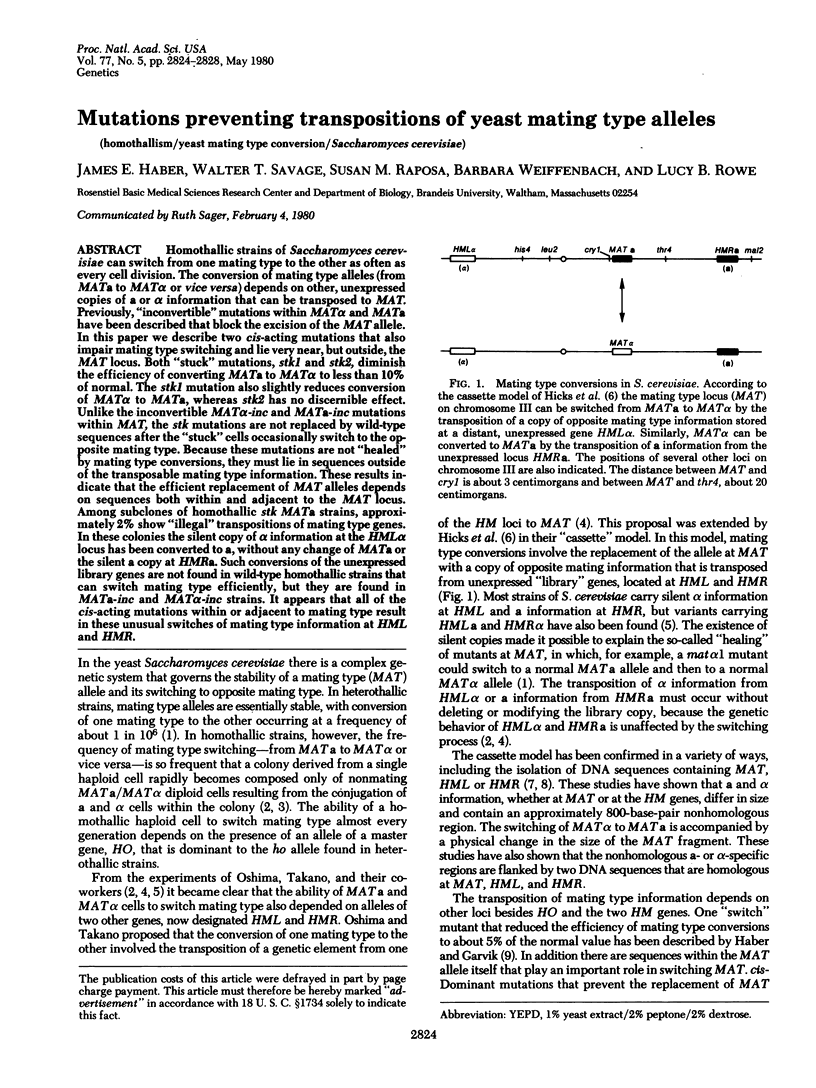
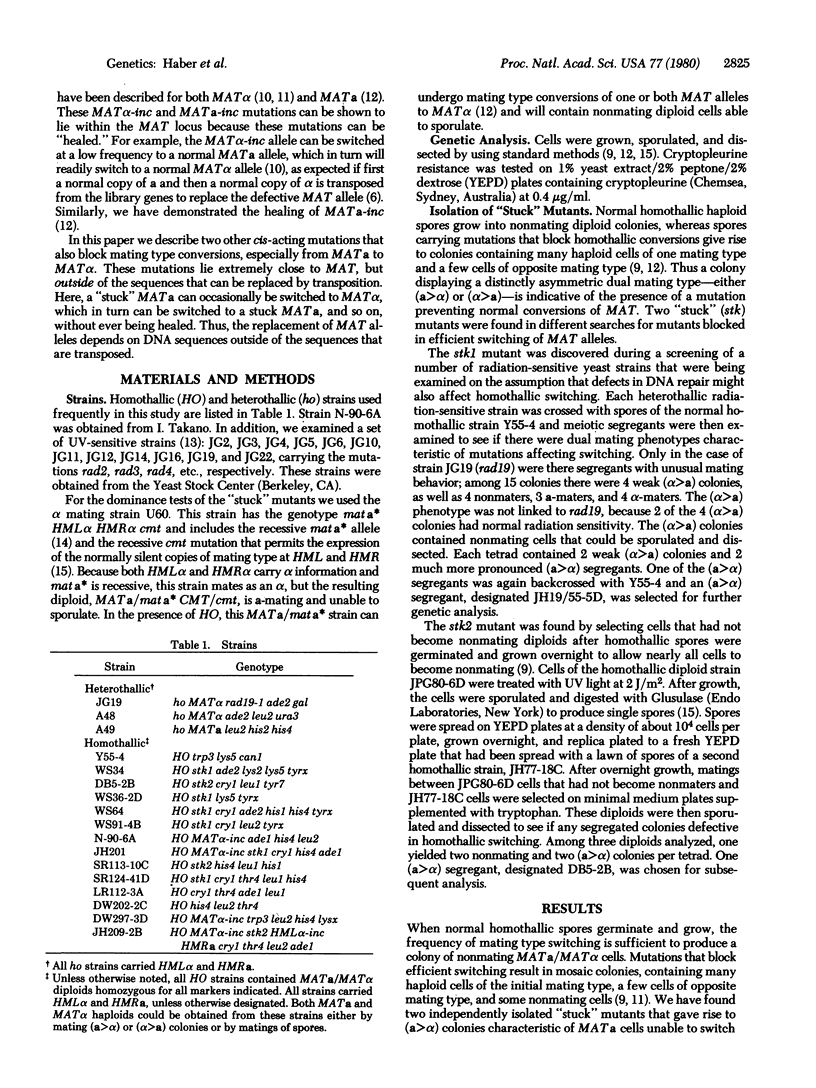
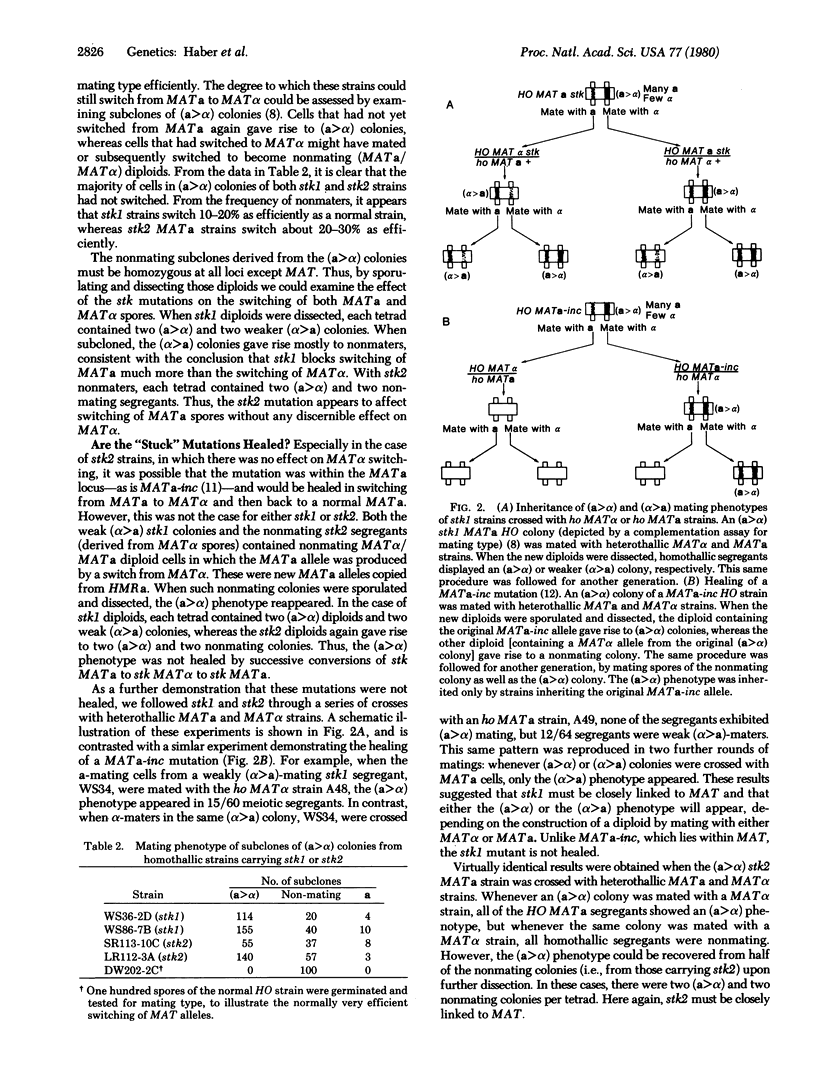
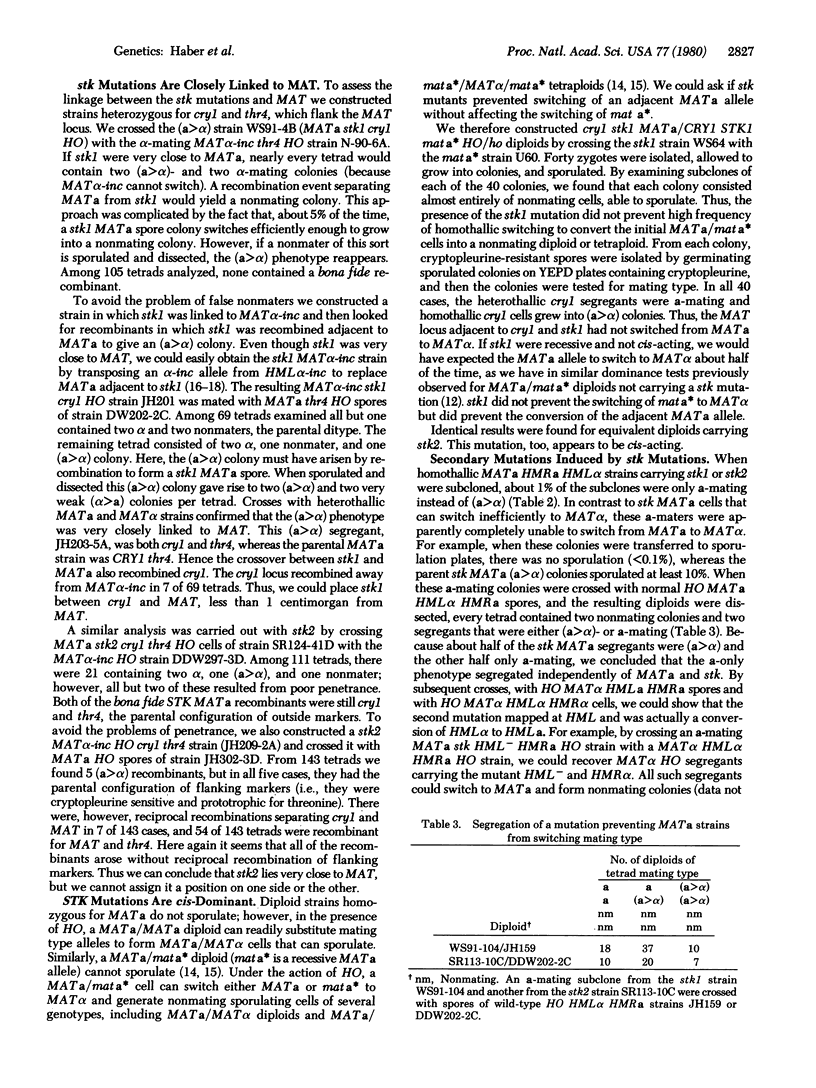
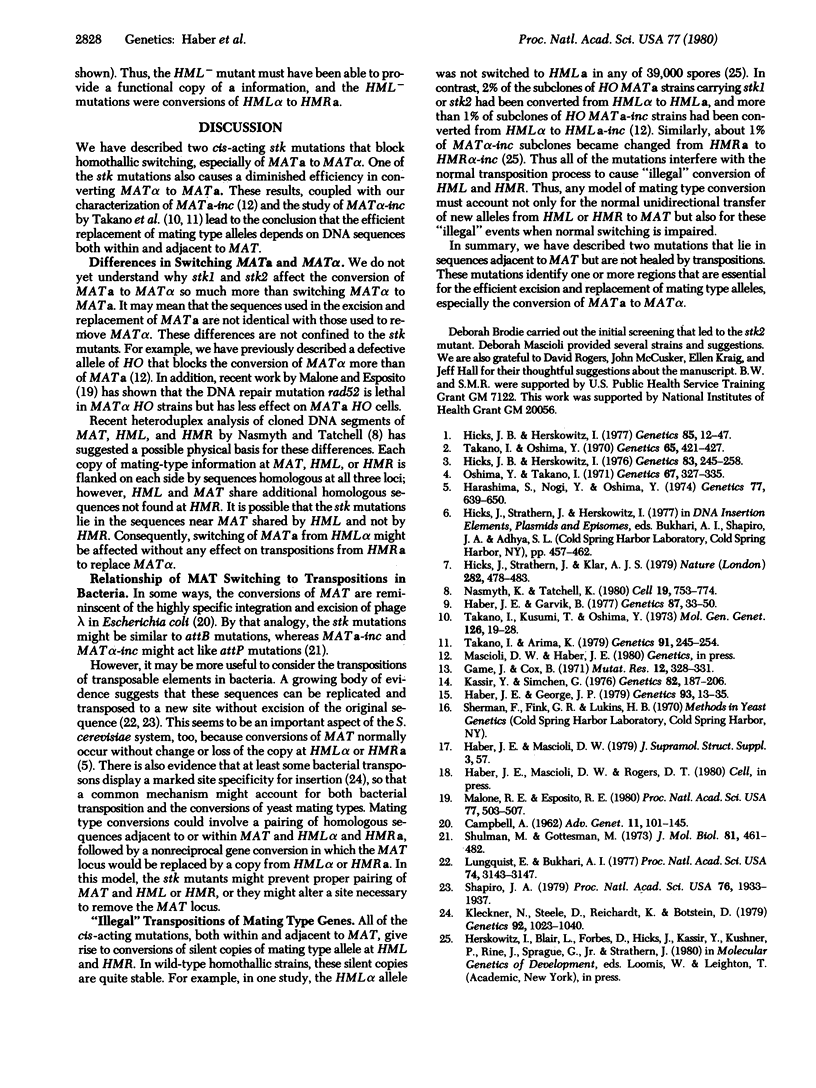
Selected References
These references are in PubMed. This may not be the complete list of references from this article.
- Haber J. E., Garvik B. A new gene affecting the efficiency of mating-type interconversions in homothallic strains of Saccharomyces cerevisiae. Genetics. 1977 Sep;87(1):33–50. doi: 10.1093/genetics/87.1.33. [DOI] [PMC free article] [PubMed] [Google Scholar]
- Haber J. E., George J. P. A mutation that permits the expression of normally silent copies of mating-type information in Saccharomyces cerevisiae. Genetics. 1979 Sep;93(1):13–35. doi: 10.1093/genetics/93.1.13. [DOI] [PMC free article] [PubMed] [Google Scholar]
- Harashima S., Nogi Y., Oshima Y. The genetic system controlling homothallism in Saccharomyces yeasts. Genetics. 1974 Aug;77(4):639–650. doi: 10.1093/genetics/77.4.639. [DOI] [PMC free article] [PubMed] [Google Scholar]
- Hicks J. B., Herskowitz I. Interconversion of Yeast Mating Types I. Direct Observations of the Action of the Homothallism (HO) Gene. Genetics. 1976 Jun;83(2):245–258. doi: 10.1093/genetics/83.2.245. [DOI] [PMC free article] [PubMed] [Google Scholar]
- Hicks J., Strathern J. N., Klar A. J. Transposable mating type genes in Saccharomyces cerevisiae. Nature. 1979 Nov 29;282(5738):478–473. doi: 10.1038/282478a0. [DOI] [PubMed] [Google Scholar]
- Kassir Y., Simchen G. Regulation of mating and meiosis in yeast by the mating-type region. Genetics. 1976 Feb;82(2):187–206. doi: 10.1093/genetics/82.2.187. [DOI] [PMC free article] [PubMed] [Google Scholar]
- Kleckner N., Steele D. A., Reichardt K., Botstein D. Specificity of insertion by the translocatable tetracycline-resistance element Tn10. Genetics. 1979 Aug;92(4):1023–1040. doi: 10.1093/genetics/92.4.1023. [DOI] [PMC free article] [PubMed] [Google Scholar]
- Ljungquist E., Bukhari A. I. State of prophage Mu DNA upon induction. Proc Natl Acad Sci U S A. 1977 Aug;74(8):3143–3147. doi: 10.1073/pnas.74.8.3143. [DOI] [PMC free article] [PubMed] [Google Scholar]
- Malone R. E., Esposito R. E. The RAD52 gene is required for homothallic interconversion of mating types and spontaneous mitotic recombination in yeast. Proc Natl Acad Sci U S A. 1980 Jan;77(1):503–507. doi: 10.1073/pnas.77.1.503. [DOI] [PMC free article] [PubMed] [Google Scholar]
- Nasmyth K. A., Tatchell K. The structure of transposable yeast mating type loci. Cell. 1980 Mar;19(3):753–764. doi: 10.1016/s0092-8674(80)80051-1. [DOI] [PubMed] [Google Scholar]
- Oshima Y., Takano I. Mating types in Saccharomyces: their convertibility and homothallism. Genetics. 1971 Mar;67(3):327–335. doi: 10.1093/genetics/67.3.327. [DOI] [PMC free article] [PubMed] [Google Scholar]
- Shapiro J. A. Molecular model for the transposition and replication of bacteriophage Mu and other transposable elements. Proc Natl Acad Sci U S A. 1979 Apr;76(4):1933–1937. doi: 10.1073/pnas.76.4.1933. [DOI] [PMC free article] [PubMed] [Google Scholar]
- Shulman M., Gottesman M. Attachment site mutants of bacteriophage lambda. J Mol Biol. 1973 Dec 25;81(4):461–482. doi: 10.1016/0022-2836(73)90517-2. [DOI] [PubMed] [Google Scholar]
- Takano I., Arima K. Evidence of the Insensitivity of the alpha-inc Allele to the Function of the Homothallic Genes in Saccharomyces Yeasts. Genetics. 1979 Feb;91(2):245–254. doi: 10.1093/genetics/91.2.245. [DOI] [PMC free article] [PubMed] [Google Scholar]
- Takano I., Kusumi T., Oshima Y. An alpha mating-type allele insensitive to the mutagenic action of the homothallic gene system in Saccharomyces diastaticus. Mol Gen Genet. 1973 Oct 16;126(1):19–28. doi: 10.1007/BF00333478. [DOI] [PubMed] [Google Scholar]
- Takano I., Oshima Y. Mutational nature of an allele-specific conversion of the mating type by the homothallic gene HO alpha in Saccharomyces. Genetics. 1970 Jul;65(3):421–427. doi: 10.1093/genetics/65.3.421. [DOI] [PMC free article] [PubMed] [Google Scholar]


